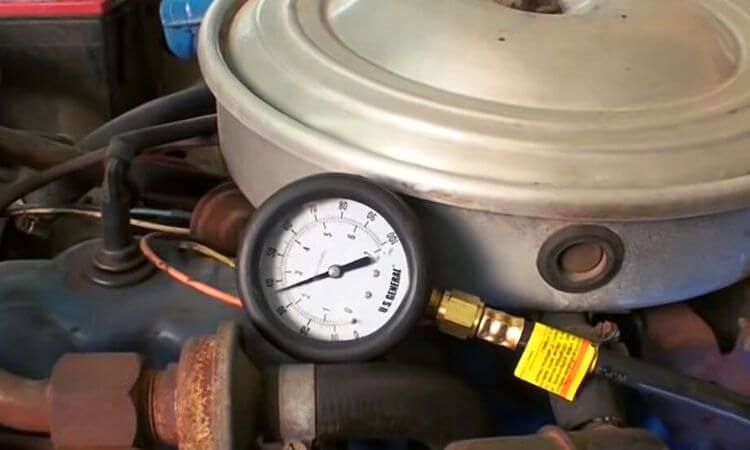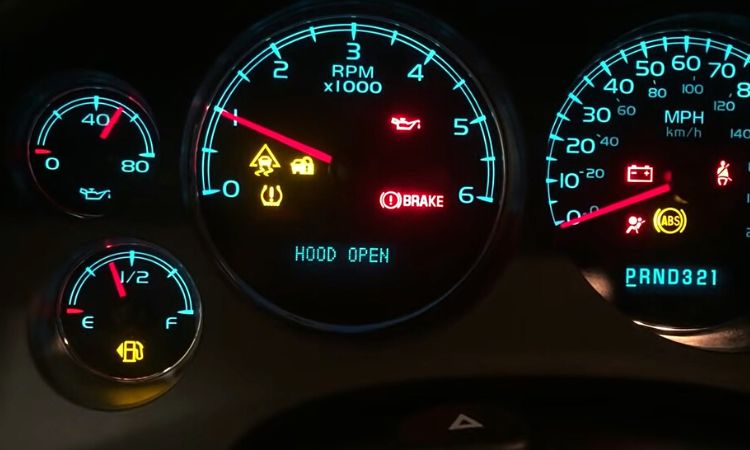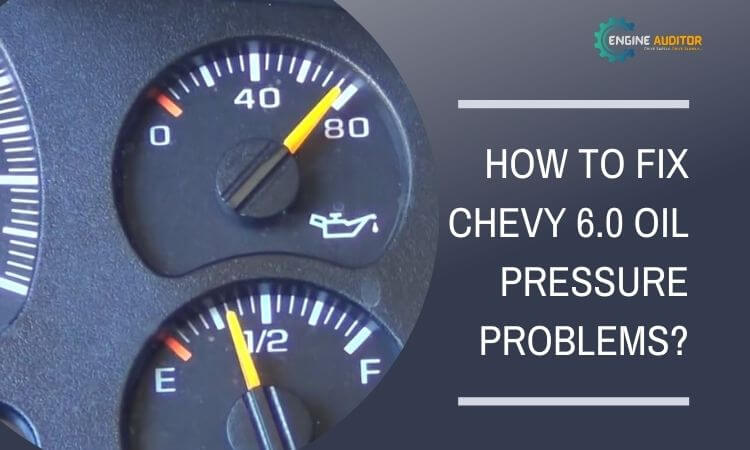Hey there! This post contains affiliate links to products. We may receive a commission for purchases made through these links. But it never influences our product selection process.
Chevy 6.0 engines are powerful, but it will be risky if the oil pressure disturbs. You need immediate fixation of the oil pressure problems to protect the chevy 6.0 engine from damage. But if you are a beginner in this field, then you need to know how to fix Chevy 6.0 oil pressure problems.
Firstly, diagnose the cause and arrange the necessary things you need to solve the problem. After that, get proper knowledge and find the right solution for each problem. Once you know the procedures, execute them perfectly to fix chevy 6.0 oil pressure problems.
What are the causes of chevy 6.0 oil pressure problems, and how to fix each one? You will find it in the below content. So read the content carefully to maintain the correct oil pressure level for your chevy 6.0 engine.
What are the causes for Chevy 6.0 oil pressure issues?

You can experience two situations when the pressure level is imbalanced. The most common issue is the low oil pressure, but sometimes you may experience high oil pressure too. Here I will explain to you the causes and fixation of oil pressure problems (for both one).
Possible causes of low oil pressure in a chevy truck:
- High or low oil viscosity
- Low oil level
- Faulty Oil pump
- Clogged Oil filter
Low oil pressure in 6.0 Chevy engine: Problems And Solutions

Problem 1: High or low oil Viscosity
Oil viscosity is essential for ensuring the correct oil flow at a certain temperature. If your oil viscosity is low or higher than recommended, you may experience low oil pressure.
If the viscosity is high, it will create resistance, and low viscosity has the opposite effect. Low-viscosity oils are suitable for cold temperatures, and higher-viscosity oils are ideal for summer.
Note: You must ensure your oil pump has the correct oil pressure.
Solution:
It is pretty easy to troubleshoot the viscosity problem in the 6.0 chevy engine. Read the manufacturer’s manual to find your engine’s correct viscosity of the oil.
For the 6.0 Chevy engine, SAE 5W-30 by Valvoline is one of the most recommended oils that ensures proper viscosity. Comparing to any other oil, it offers you 25% better safety against deposits.
Problem 2: Low Oil Level
If the oil level drops below the minimum recommendation, you may also experience low oil pressure issues. It should never go below the minimum dipstick line. It can happen anytime, even if you have changed the oil recently.
The low oil level will make the oil supply inconsistent for lubrication; if it goes for a long time, you may experience a seized engine.
Solution 2:
Check the oil level in the oil tank. Make sure it is above enough than the minimum dipstick line. If it is below or a little above the line, immediately refill the tank up to the recommended level with the correct oil.
Problem 3: Faulty Oil Pump
The oil pump is the major part responsible for the oil pressure. Malfunctioning of oil pumps can cause low oil pressure in chevy engines.
Not only the low pressure, but if the oil pump is faulty, you may also experience engine heating, a decrease in performance, and engine stalling.
Solution 3:
Go through the oil pump, and check for leakage or clogging. If you see the oil pump has leakage, fix it with tape.
But if it is irreparable, replace the oil pump. You can check M295 Oil Pump for Chevy 6.0 model. Also it is ideal for GMC Sierra, Suburban, Cadillac LS1 LS3 LS2 LS6 4.8L 5.3L 6.0L.
I suggest it to use because it is long lasting and ensures OEM standards.
Note: Check the clogging if the oil pump is clogged. Remove it and clean it with the carb cleaners to ensure clean passage of oil and reinstall it.
Problem 4: Clogged Oil Filter
An oil filter is responsible for removing dirt, contaminants, and debris from oil. But over time, these particles accumulate in the oil filter and cause clogging of the oil filter. Once the oil filter is clogged, it decreases the oil flow and lowers the oil pressure.
It is risky for your engine; if you do not pay attention, you may experience engine stalling. Immediately arrange for cleaning or replacing the dirty oil filter.
Solution 4:
Check the oil filter if it is in average condition, and you can solve the problem by cleaning it. Do the cleaning; you can use carb cleaners for cleaning and removal of dust or dirt particles. But if the oil filter is too dirty, then replace the oil filter instead of repairing it.
I suggest you to use K&N Premium Oil Filter which is highly compatible with CHEVROLET/GMC/HUMMER. It is designed for maintaining exceptional flow rate and consistent flow of oil to the engine.
What causes high oil pressure in a chevy truck?
- Wrong Oil Grade
- Faulty oil pressure sensors
- Malfunctioned Relief Valve
- Poor Quality Oil
High oil pressure in 6.0 Chevy engine: Problems And Solutions

Problem 1: Wrong Oil Grade
Experimenting with multiple oil grades for your 6.0 chevy engine may save you money, but it can be a bad decision. If the oil grade is wrong, you may fill your tank with thin viscous oil that may increase the oil pressure.
Solution:
Check the user manual or consult with the expert to get the correct oil grade for your chevy 6.0 engines.
Problem 2: Faulty Oil Pressure Sensors
Your engine’s oil pressure sensors can be the culprit for high oil pressure. Faulty sensors will show you false signals to gauge the pressure.
If you experience too much engine noise, vibration, or smoke, you should check for the pressure level. If everything looks OK, like the oil filter and oil pump, you have a problem with pressure sensors.
Solution 2:
Pressure sensors give wrong signals if they are broken or displaced. Check the sensors, and replace them with fresh ones if you see damage, but if they are displaced, place them in the correct place.
Note: My favorite recommendation is Oil Pressure Sensor by TeileHaus which is Compatible with Chevy Silverado.
Problem 3: Malfunctioned Relief Valve
The relief valve releases the excessive oil when the pressure is too high. If the relief valve is faulty, it will fail to perform its basic task. Resultantly you will experience high oil pressure.
Solution 3:
Relief valve issues can be clogged valves or damaged valves. Check for clogging first. If it is clogged, arrange for its cleaning to clear the line for releasing of excessive oil, but if you see the valve is damaged, replace it. The relief valve is located inside the oil pump.
Problem 4: Low Oil Quality
Low-quality oil may cause problems with their grades. If you have low-quality oil, it may cause high oil pressure.
Solution 4:
It is pretty simple because you know what quality oil you have filled in the tank. If you experience inconsistent performance, immediately remove the low-quality oil and refill with recommended oil.
Got Some Questions?
What is normal oil pressure in a Chevy Silverado?
What is the normal oil pressure for a car?
How to check low oil pressure on 6.0 Powerstroke?
How to test oil pressure 6.0 Powerstroke?
Final Takeaway
For the consistent performance of the chevy 6.0 engine, you should provide the correct oil pressure level. If not, then be ready for experiencing chevy 6.0 oil pressure problems.
Once you find a problem, solve it ASAP; Otherwise, you may face severe damage to your engine. You can also take the help of an automated expert, if you find yourself unfit for this DIY job.

